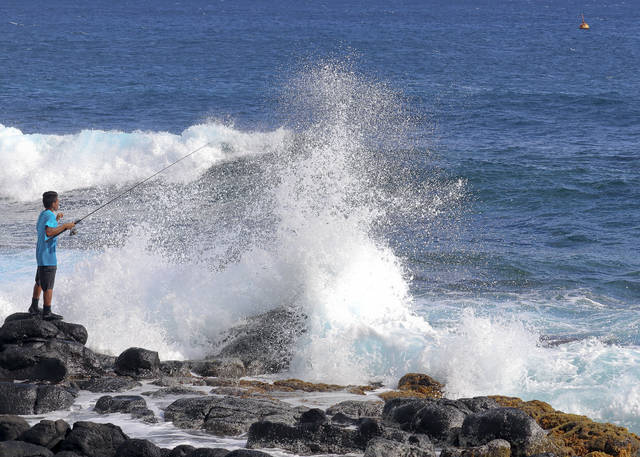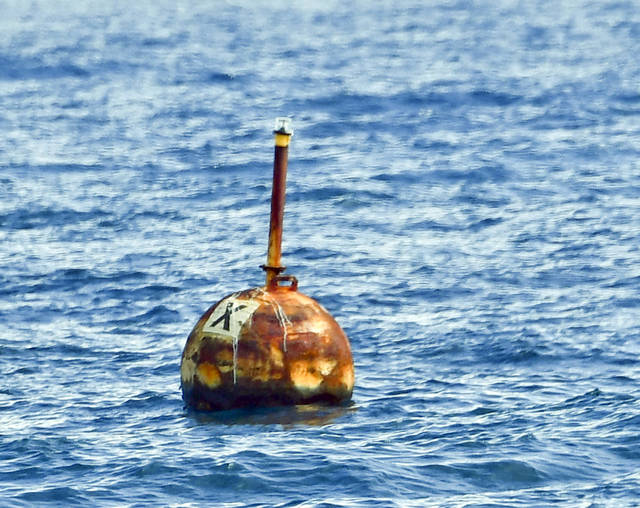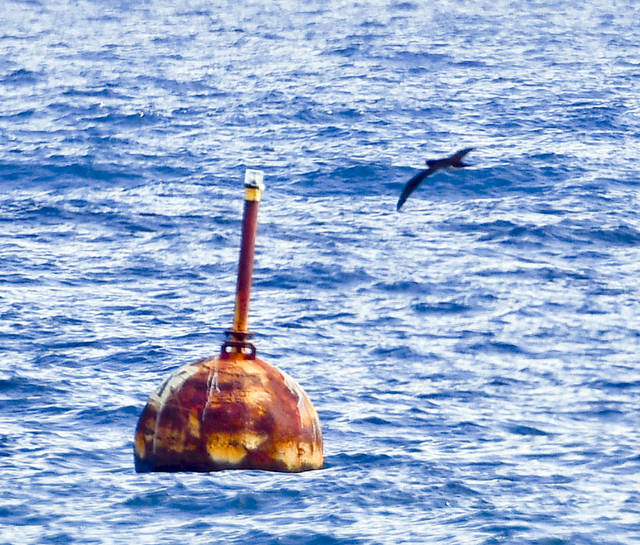LIHUE — A buoy is floating about 200 yards offshore at Ahukini Landing, seemingly snagged on something in the water below.
First discovered over Christmas weekend, the buoy is a state fish aggregating device, according to members of the U.S. Coast Guard who confirmed the buoy Tuesday.
It is between 200 and 300 yards makai of Hanamaulu Bay, according to the state Department of Land and Natural Resources Division of Boating and Ocean Recreation Kauai Branch Manager Joe Borden, and its anchor chain is stuck on the bottom.
The buoy belongs to either University of Hawaii or the state DLNR Division of Aquatic Resources, said Dan Dennison, DLNR spokesman.
Representatives from UH and the state FAD program couldn’t be reached for comment before press time.
“It’s not being tracked, but monitored,” Dennison said. “If/when it breaks free and comes ashore, then DOBOR will remove it. However, if DAR and/or UH can retrieve it before it comes ashore, they can actually place it back where it belongs.”
Buoys, fishing equipment, and other marine debris pose a threat to marine life in Hawaii waters, and also to the migratory humpback whales, which have already started the 2,000-nautical mile journey from Alaska to Kauai.
The dangers of debris became apparent in the waters off Maui on Monday when trained responders freed an entangled humpback whale off Lahaina. It’s the third response the Hawaiian Islands Humpback Whale National marine Sanctuary’s entanglement responders have conducted since the opening of the 2017 whale migration season.
The whale was trailing about 400 feet of heavy gauge line from its mouth and was first reported about 11:50 a.m. by the crew aboard an Ultimate Whale Watch boat, Wahine Kai.
The Hawaiian Islands Humpback Whale National Marine Sanctuary’s response vessel, Kohola, responded about 2:20 p.m. and the whale was freed about 4:45 p.m. by the entanglement team, with Coast Guard waiting to assist.
Derelict fishing gear could be coming from various places — the Pacific gyre, the journey from Alaska, or local equipment.
“It is anything and everything in the water column that can entangle whales, and any marine life for that matter,” said Ed Lyman, response coordinator. “There are these buoy lines, moorings and then it’s (also) scientific gear, like the hydrophones, that have caught whales as well.”
Residents, mariners and visitors are encouraged to get involved when they see marine debris as well as entangled whales and the best way to do it is to report it to the right place.
Reports of marine debris that’s drifting in state waters or washed up on the shoreline, removed from the water and secured on land, or debris too large and heavy where help is needed, go to DLNR’s Division of Boating and Ocean Recreation.
Online, DOBOR has a marine debris response and removal reporting form that will notify the correct people within the entity to handle the report. That form can be found at dlnr.hawaii.gov/dobor/reportmarinedebrishawaii.
“This report form has been approved through the chair’s office and that is the way to start that conversation so the right localities are informed and the right people are put in place,” Manuel said.
He continued: “It might not seem like things are moving but that’s the process that’s been agreed upon throughout the state.”
Anyone who sees a whale entangled in debris should also contact trained experts.
It’s extremely dangerous for untrained people to try and disentangle a whale themselves. Experts emphasize the best way people can help is by reporting sightings to the NOAA 24/7 response hotline: 1-888-256-9840.
Another way to report an entangled whale is to radio the U.S. Coast Guard on VHF CH. 16 and they will relay the report.
Finding debris like the buoy isn’t uncommon, especially with the winter currents on the island’s windward side, according to National Oceanic and Atmospheric Administration officials.
“The Main Hawaiian Islands and the Northwest Hawaiian Islands are really prone to having debris accumulate on our beaches and coastal waters,” said Mark Manuel, Pacific Islands marine debris regional coordinator for NOAA.
He continued: “It’s because of our geographic location in relation to the Pacific gyre, which brings out the fishing gear and debris and funnels it to the Hawaiian Archipelago.”
Thousands of pounds of marine debris reach Kauai’s shores due to the Pacific gyre, according to members of the Kauai Chapter of Surfrider and NOAA.
And while much of that debris comes from the Pacific gyre, the buoy near Ahukini appears to be a “discrepant private aid” according to the Coast Guard — a FAD buoy used by the state in conjunction with University of Hawaii to attract fish for easy catching.
Pelagic fishes like tuna, mahimahi, ono and billfish are attracted to the buoys.
While representatives from UH couldn’t be reached for comment, the FAD website, updated Dec. 15, gives a list of missing buoys.
The buoy floating at Ahukini Landing is marked with a large, white X, which corresponds to one of the five buoys missing from Oahu.
Four are missing from Kauai — marked AA, KK, PP and Z. Five buoys are missing from Maui, and four are missing from Hawaii Island.
The buoy is floating within the three-mile border between state and federal waters, making it under the jurisdiction of the state’s Department of Land and Natural Resources, according to Hawaii Administrative Rules.










